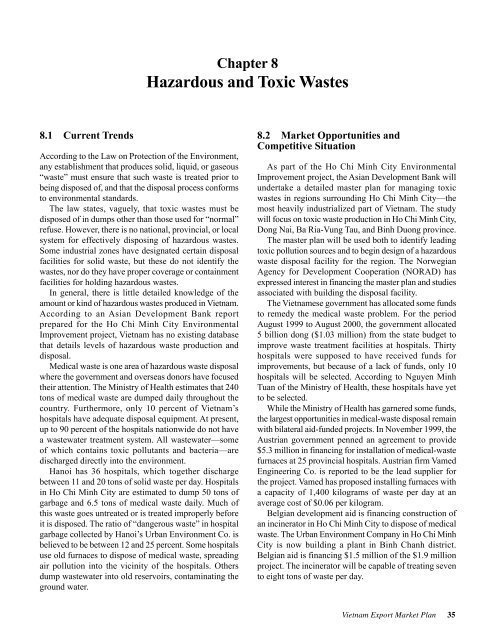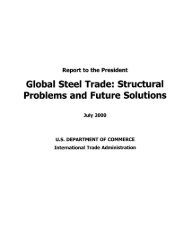Vietnam Environmental Technologies Export Market Plan
Vietnam Environmental Technologies Export Market Plan
Vietnam Environmental Technologies Export Market Plan
Create successful ePaper yourself
Turn your PDF publications into a flip-book with our unique Google optimized e-Paper software.
Chapter 8<br />
Hazardous and Toxic Wastes<br />
8.1—Current Trends<br />
According to the Law on Protection of the Environment,<br />
any establishment that produces solid, liquid, or gaseous<br />
“waste” must ensure that such waste is treated prior to<br />
being disposed of, and that the disposal process conforms<br />
to environmental standards.<br />
The law states, vaguely, that toxic wastes must be<br />
disposed of in dumps other than those used for “normal”<br />
refuse. However, there is no national, provincial, or local<br />
system for effectively disposing of hazardous wastes.<br />
Some industrial zones have designated certain disposal<br />
facilities for solid waste, but these do not identify the<br />
wastes, nor do they have proper coverage or containment<br />
facilities for holding hazardous wastes.<br />
In general, there is little detailed knowledge of the<br />
amount or kind of hazardous wastes produced in <strong>Vietnam</strong>.<br />
According to an Asian Development Bank report<br />
prepared for the Ho Chi Minh City <strong>Environmental</strong><br />
Improvement project, <strong>Vietnam</strong> has no existing database<br />
that details levels of hazardous waste production and<br />
disposal.<br />
Medical waste is one area of hazardous waste disposal<br />
where the government and overseas donors have focused<br />
their attention. The Ministry of Health estimates that 240<br />
tons of medical waste are dumped daily throughout the<br />
country. Furthermore, only 10 percent of <strong>Vietnam</strong>’s<br />
hospitals have adequate disposal equipment. At present,<br />
up to 90 percent of the hospitals nationwide do not have<br />
a wastewater treatment system. All wastewater—some<br />
of which contains toxic pollutants and bacteria—are<br />
discharged directly into the environment.<br />
Hanoi has 36 hospitals, which together discharge<br />
between 11 and 20 tons of solid waste per day. Hospitals<br />
in Ho Chi Minh City are estimated to dump 50 tons of<br />
garbage and 6.5 tons of medical waste daily. Much of<br />
this waste goes untreated or is treated improperly before<br />
it is disposed. The ratio of “dangerous waste” in hospital<br />
garbage collected by Hanoi’s Urban Environment Co. is<br />
believed to be between 12 and 25 percent. Some hospitals<br />
use old furnaces to dispose of medical waste, spreading<br />
air pollution into the vicinity of the hospitals. Others<br />
dump wastewater into old reservoirs, contaminating the<br />
ground water.<br />
8.2—<strong>Market</strong> Opportunities and<br />
Competitive Situation<br />
As part of the Ho Chi Minh City <strong>Environmental</strong><br />
Improvement project, the Asian Development Bank will<br />
undertake a detailed master plan for managing toxic<br />
wastes in regions surrounding Ho Chi Minh City—the<br />
most heavily industrialized part of <strong>Vietnam</strong>. The study<br />
will focus on toxic waste production in Ho Chi Minh City,<br />
Dong Nai, Ba Ria-Vung Tau, and Binh Duong province.<br />
The master plan will be used both to identify leading<br />
toxic pollution sources and to begin design of a hazardous<br />
waste disposal facility for the region. The Norwegian<br />
Agency for Development Cooperation (NORAD) has<br />
expressed interest in financing the master plan and studies<br />
associated with building the disposal facility.<br />
The <strong>Vietnam</strong>ese government has allocated some funds<br />
to remedy the medical waste problem. For the period<br />
August 1999 to August 2000, the government allocated<br />
5 billion dong ($1.03 million) from the state budget to<br />
improve waste treatment facilities at hospitals. Thirty<br />
hospitals were supposed to have received funds for<br />
improvements, but because of a lack of funds, only 10<br />
hospitals will be selected. According to Nguyen Minh<br />
Tuan of the Ministry of Health, these hospitals have yet<br />
to be selected.<br />
While the Ministry of Health has garnered some funds,<br />
the largest opportunities in medical-waste disposal remain<br />
with bilateral aid-funded projects. In November 1999, the<br />
Austrian government penned an agreement to provide<br />
$5.3 million in financing for installation of medical-waste<br />
furnaces at 25 provincial hospitals. Austrian firm Vamed<br />
Engineering Co. is reported to be the lead supplier for<br />
the project. Vamed has proposed installing furnaces with<br />
a capacity of 1,400 kilograms of waste per day at an<br />
average cost of $0.06 per kilogram.<br />
Belgian development aid is financing construction of<br />
an incinerator in Ho Chi Minh City to dispose of medical<br />
waste. The Urban Environment Company in Ho Chi Minh<br />
City is now building a plant in Binh Chanh district.<br />
Belgian aid is financing $1.5 million of the $1.9 million<br />
project. The incinerator will be capable of treating seven<br />
to eight tons of waste per day.<br />
<strong>Vietnam</strong> <strong>Export</strong> <strong>Market</strong> <strong>Plan</strong><br />
35
















